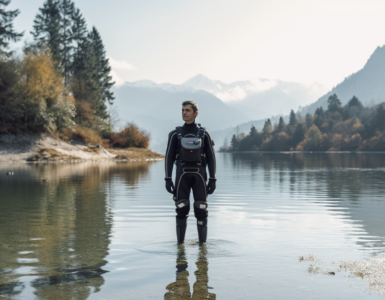Have you ever wondered what makes a wet suit so efficient at keeping you warm while you’re having fun in the water? Wet suits are a vital piece of gear for a wide range of water sports, from surfing and scuba diving to triathlon and canyoneering. In this article, we will explore the materials used in wet suits, the various types available, and some of the leading brands in the market. So let’s dive in and learn more about these amazing pieces of technology that make our water adventures more enjoyable and safe.
Understanding the Materials Used in Wet Suits
The primary material used in most wet suits is neoprene. This synthetic rubber is highly flexible and has excellent insulating properties. It works by trapping a thin layer of water between the suit and your skin, which your body heat then warms, providing insulation against the cold water. But did you know that neoprene isn’t the only material used in wet suits? That’s right, many manufacturers blend neoprene with other materials such as spandex or nylon to enhance its performance and durability.
Importance of Wet Suit Material
The material of your wet suit can significantly impact your comfort and performance in the water. Ever tried to swim in a suit that’s too tight or too loose? It’s not a pleasant experience. That’s why the flexibility of the material is crucial. It allows you to move freely and comfortably. The material’s insulating properties are also vital. After all, staying warm in cold water is the primary reason we wear wet suits, isn’t it?
Now, imagine a material that not only keeps you warm but also enhances your performance. Some wet suit materials are designed to reduce drag in the water, helping you swim faster and more efficiently. Isn’t that fascinating?
Different Types of Wet Suits
Ever wondered why there are so many different types of wetsuits? The truth is, different water activities and varying water temperatures require diverse suit types. Let’s take a closer look at some of the main types of wetsuits: full suits, shorties, spring suits, and diving suits.
Full Suits
Full suits, as the name suggests, cover the entire body – arms, legs, and torso. These suits are designed for colder waters, typically below 68°F (20°C). They are made of thicker neoprene to provide maximum insulation. Full suits are your best friends when dealing with colder temperatures. But remember, they might restrict mobility a bit compared to other types. So, when comfort is key, should you consider other options?
Shorties and Spring Suits
Shorties and spring suits are perfect for warmer waters. Shorties cover the torso and extend to the thighs and upper arms, leaving your limbs free for better movement. Spring suits, on the other hand, cover the full length of the arms but stop at the knees. They provide a balance between insulation and flexibility, making them a great choice for activities requiring more agility. Are you a surfer or a diver? Then you might want to think about these options!
Customizations and Special Features
Did you know that you can customize your wetsuit? Yes, you heard it right! Customization options and special features like hoods, gloves, and boots can enhance the functionality of a wet suit. These features not only provide additional warmth but also offer protection against underwater hazards.
For example, hoods are great for very cold waters, helping to prevent loss of body heat through the head. Gloves and boots provide additional insulation for the hands and feet, which can get quite cold during prolonged water exposure. Are you diving in colder waters or exploring underwater caves? These add-ons might be just what you need!
Remember, a good wetsuit is not just about the fit and material—it’s also about the features that make your water adventures safer and more comfortable. So, when choosing a wetsuit, don’t forget to consider these special features!
Leading Brands in the Wet Suit Market
When it comes to wet suits, there’s no shortage of brands to choose from. But how do you know which one is the best for you? Well, we’re here to help you out with that. Let’s take a look at some of the leading brands in the wet suit market.
| Brand | Popular Models | Unique Features |
|---|---|---|
| O’Neill | HyperFreak, Psycho One | Technobutter 3 & 3X neoprene, minimal seam design |
| Rip Curl | E-Bomb, FlashBomb | E5 Flash lining, key pocket |
| Patagonia | R1, R2, R3 | Yulex natural rubber, fair trade certified |
| Xcel | Comp X, Drylock X | Channel Flex exterior, Celliant Black lining |
| Billabong | Furnace Absolute, Furnace Carbon | Graphene lining, no-soak external jersey |
Tips to Choose the Right Wet Suit
With so many options out there, choosing the right wet suit can seem like a daunting task. But don’t worry, we’ve got you covered. Here are some tips to help you make the right decision:
First, consider the fit. A well-fitted wet suit should feel like a second skin, snug but not restrictive. Think about the thickness too. The colder the water, the thicker the wet suit needs to be. And don’t forget the type of wet suit. Full suits are great for colder waters, while shorties and spring suits are perfect for warmer climates.
Remember, the right wet suit is the one that fits your needs and provides you with comfort and flexibility.
Caring for Your Wet Suit
Once you’ve found the perfect wet suit, you’ll want to take good care of it. Here are some tips on maintaining your wet suit to extend its life:
Clean your wet suit with fresh water after each use. Avoid using harsh detergents as they can damage the neoprene. Allow it to dry naturally, but avoid direct sunlight as UV rays can degrade the material. Store your wet suit in a cool, dry place to prevent mold and mildew growth.
With proper care, your wet suit can last for many seasons, giving you the best value for your investment.
Innovations in Wet Suit Technology
Have you ever wondered about the latest advancements in wetsuit technology? It’s amazing how far we’ve come! In recent years, we’ve seen significant innovations in the materials and designs used in wetsuits. Thermalite, for instance, is a new type of heat-reflective material that’s being increasingly used in wetsuits. It’s designed to reflect the body heat back to the wearer, providing an extra layer of warmth. Pretty cool, right?
Then there’s Geoprene, a limestone-based neoprene that’s lighter, warmer, and more eco-friendly than traditional petroleum-based neoprene. It’s amazing to see how manufacturers are continually pushing the boundaries to enhance performance and comfort, while also making an effort to be more sustainable.
Conclusion and Final Thoughts
So there you have it – a comprehensive look at what wetsuits are made of, the different types available, some of the leading brands, and the latest innovations in wetsuit technology. We hope this blog post has given you a deeper understanding of wetsuits and their importance in water sports.
Choosing a wetsuit isn’t just about picking the first one you see on the rack. It’s about finding a suit that fits you perfectly, suits your needs, and is made of materials that will keep you warm and flexible in the water. And remember, taking good care of your wetsuit can greatly extend its lifespan, so it’s worth investing some time in maintenance!
Isn’t it fascinating to see how a seemingly simple piece of gear can have so much science and technology behind it? Let’s appreciate the innovation and thought that goes into every stitch of our wetsuits.
- Wetsuits are primarily made of neoprene, a type of synthetic rubber that provides excellent insulation and flexibility.
- There are different types of wetsuits available, including full suits, shorties, spring suits, and diving suits. Each type is designed for a specific use case.
- Some of the leading brands in the wetsuit market include O’Neill, Rip Curl, and Hurley.
- Recent advancements in wetsuit technology include the use of innovative materials like Thermalite and Geoprene.
- Choosing the right wetsuit involves considering factors like fit, thickness, type, and brand. Regular maintenance can extend the life of your wetsuit.




